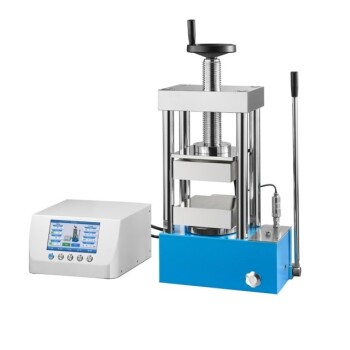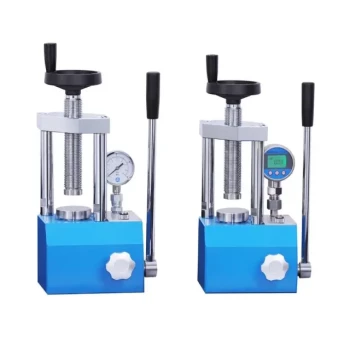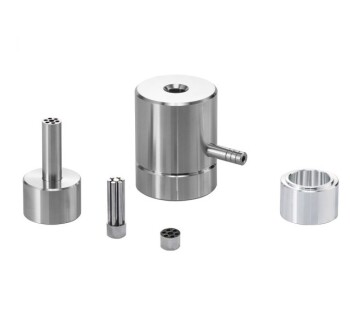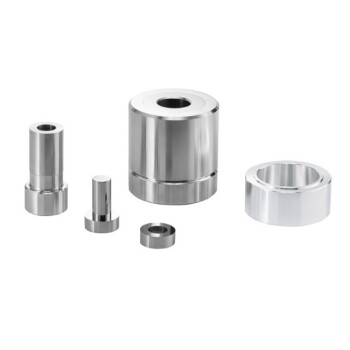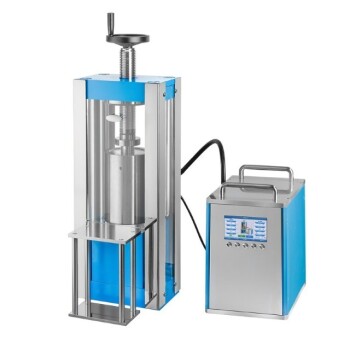In advanced manufacturing, the challenge is to create materials that are not just formed, but fundamentally optimized. Hot pressing achieves this by combining heat and pressure simultaneously in a single, highly controlled process. This method allows for the creation of parts with superior density, enhanced mechanical properties, and exceptional microstructural control that are often unattainable with other techniques.
The core advantage of hot pressing is not just that it combines heat and pressure, but that it uses this synergy to solve a fundamental problem: eliminating porosity. By making the material pliable with heat while simultaneously applying pressure to collapse internal voids, the process creates a final product that is significantly denser and stronger.
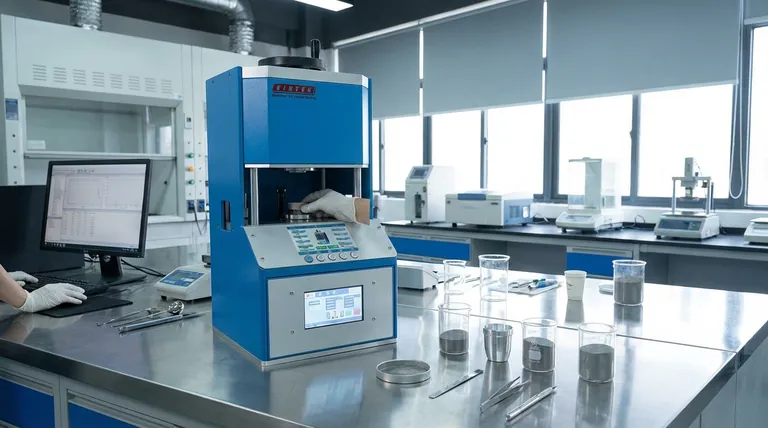
How Hot Pressing Delivers Superior Material Properties
The defining characteristic of hot pressing is the simultaneous application of thermal and mechanical energy. This combination is what unlocks its most significant benefits.
The Synergy of Heat and Pressure
Heat lowers the material's yield strength, making it more plastic and easier to deform. At the same time, applied pressure forces the material particles together, promoting diffusion and plastic flow to fill any voids.
This synergy drastically accelerates the densification process compared to methods that apply heat and pressure sequentially, such as traditional sintering.
Achieving Near-Theoretical Density
The primary goal of many consolidation processes is to eliminate porosity, or the empty space between powder particles. These voids are inherent weaknesses in a finished part.
Hot pressing excels at creating parts with very high density, often approaching 100% of the material's theoretical maximum. This is a direct result of pressure being applied while the material is hot and malleable.
Enhancing Mechanical Strength and Performance
A material's density is directly correlated with its mechanical properties. By eliminating pores, hot pressing significantly improves hardness, fracture toughness, and overall strength.
Furthermore, the process can facilitate desirable phase transformations within the material's crystalline structure, further enhancing its final properties for specific performance requirements.
Gaining Unparalleled Process Control
Beyond the final material properties, hot pressing provides a level of control over the manufacturing process itself that is critical for high-stakes applications.
Precision in Temperature and Force
Modern hot presses, especially hydraulic systems, offer extremely precise control over temperature, pressure application, and heating/cooling rates. This ensures uniformity and consistency from part to part.
This level of automation and precision minimizes variability and allows for the development of highly repeatable manufacturing protocols, which is critical for quality assurance.
Preventing Oxidation with a Controlled Atmosphere
Many advanced materials, including certain metals and ceramics, are highly susceptible to oxidation at elevated temperatures, which can degrade their properties.
Hot pressing is frequently performed in a vacuum or an inert gas environment. This protective atmosphere prevents unwanted chemical reactions, preserving the material's purity and ensuring optimal performance.
Minimizing Deformation and Defects
Because pressure is applied uniformly in a contained die, hot pressing minimizes the warping or distortion that can occur in other high-temperature processes.
This results in parts with a superior surface finish and excellent dimensional accuracy, often reducing the need for extensive secondary machining.
Understanding the Trade-offs
No process is without limitations. Objectivity requires acknowledging where hot pressing may not be the ideal choice.
Equipment Cost and Complexity
Hot press systems, particularly those incorporating vacuum or inert atmosphere capabilities, represent a significant capital investment compared to conventional furnaces or cold presses.
The machinery is more complex, potentially leading to higher maintenance costs and the need for more specialized operator training.
Cycle Time Considerations
While hot pressing is often faster than a separate pressing and free-sintering cycle, it can be slower than other high-volume manufacturing methods like metal injection molding or die casting.
Heating, soaking, pressing, and cooling all occur within the machine, making the per-part cycle time a key factor for production planning.
Geometric Limitations
The shapes that can be produced are generally limited to what can be ejected from a rigid die. Complex geometries with undercuts or internal cavities are typically not feasible with traditional uniaxial hot pressing.
Making the Right Choice for Your Application
Selecting the right process depends entirely on your material, geometry, and performance goals.
- If your primary focus is achieving maximum density and mechanical performance: Hot pressing is an exceptional choice, especially for high-performance ceramics, composites, and powder metals.
- If your primary focus is cost-effective, high-volume production of simple shapes: Carefully evaluate the cycle time and equipment cost against alternatives like conventional press-and-sinter powder metallurgy.
- If your primary focus is creating complex net-shape parts: You may need to explore alternative processes like injection molding or additive manufacturing, as hot pressing is best suited for simpler geometries.
Ultimately, hot pressing empowers you to create materials with properties that are dictated by design, not limited by process.
Summary Table:
| Advantage | Description |
|---|---|
| Superior Density | Achieves near-theoretical density by eliminating porosity through simultaneous heat and pressure. |
| Enhanced Mechanical Properties | Improves hardness, fracture toughness, and strength due to reduced voids and phase transformations. |
| Process Control | Offers precise temperature, pressure, and atmosphere control for consistent, high-quality results. |
| Reduced Defects | Minimizes deformation and oxidation, leading to better surface finish and dimensional accuracy. |
Ready to enhance your laboratory's capabilities with advanced hot pressing solutions? KINTEK specializes in lab press machines, including automatic lab presses, isostatic presses, and heated lab presses, designed to deliver superior density, strength, and process control for your materials. Contact us today to discuss how our equipment can optimize your manufacturing processes and meet your specific needs—get in touch now!
Visual Guide
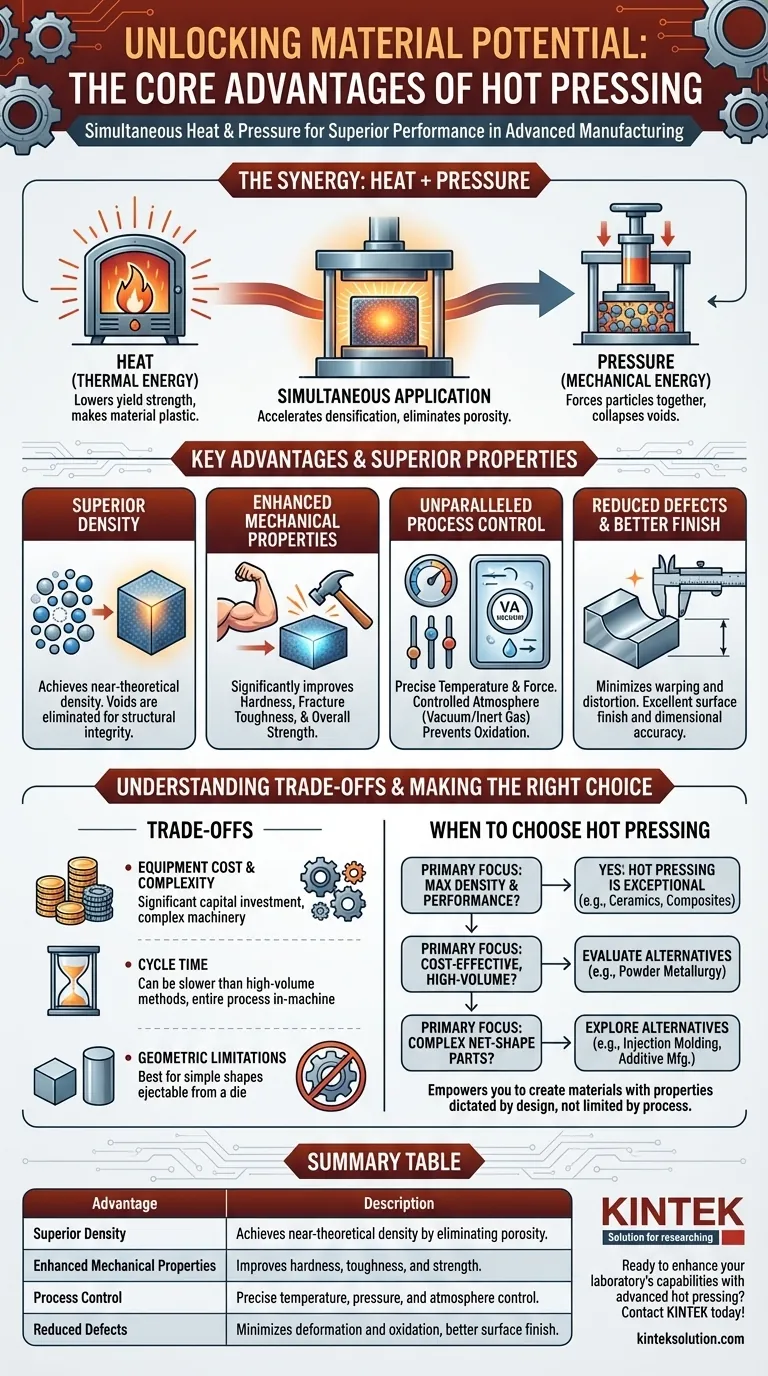
Related Products
- Automatic High Temperature Heated Hydraulic Press Machine with Heated Plates for Lab
- 24T 30T 60T Heated Hydraulic Lab Press Machine with Hot Plates for Laboratory
- Laboratory Manual Heated Hydraulic Press Machine with Hot Plates
- Heated Hydraulic Press Machine with Heated Plates for Vacuum Box Laboratory Hot Press
- Automatic Heated Hydraulic Press Machine with Hot Plates for Laboratory
People Also Ask
- What is the core function of a heated hydraulic press? Achieve High-Density Solid-State Batteries
- What is a heated hydraulic press and what are its main components? Discover Its Power for Material Processing
- How are heated hydraulic presses applied in the electronics and energy sectors? Unlock Precision Manufacturing for High-Tech Components
- What role does a heated hydraulic press play in powder compaction? Achieve Precise Material Control for Labs
- Why is a hydraulic heat press critical in research and industry? Unlock Precision for Superior Results

